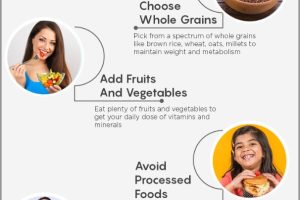The Ultimate Guide to Healthy Eating for a Fit Body

Importance of Healthy Eating
Embarking on a journey toward a healthier lifestyle starts with understanding the fundamental role that healthy eating plays. Not only does nutritious food supply the essential vitamins and minerals our bodies need, but it also fuels daily activities and supports overall well-being. For many, this may involve reevaluating their current diet and recognizing the benefits that come with balanced nutrition. Consider incorporating whole foods like:
- The Ultimate Guide to Healthy Eating for a Fit Body
- Importance of Healthy Eating
- Benefits of a Fit Body
- Understanding Nutrition
- Macronutrients
- Micronutrients
- Building a Balanced Diet
- Food Groups to Include
- Portion Control Tips
- Meal Planning for Success
- Creating Nutrient-Dense Meals
- Healthy Snack Ideas
- Hydration for Health
- Importance of Drinking Water
- Choosing Healthy Beverages
- Mindful Eating Practices
- Eating Slowly and Mindfully
- Listening to Your Body's Hunger Cues
- Healthy Eating on a Budget
- Tips for Affordable Grocery Shopping
- Cooking Healthy Meals at Home
- Dining Out Strategies
- Making Smart Menu Choices
- Portion Control When Eating Out
- Meal Prep for Busy Lifestyles
- Batch Cooking Tips
- Planning Ahead for Success
- Fighting Cravings and Emotional Eating
- Understanding Triggers
- Healthy Alternatives to Fatty and Sugary Foods
- Fruits and vegetables
- Whole grains
- Lean proteins
- Healthy fats
These choices don’t just enhance physical health; they can also improve mood and energy levels, making daily tasks feel less daunting.
Benefits of a Fit Body
A fit body isn’t just about aesthetics; it’s a reflection of a vibrant and energized life. Regular physical activity, paired with healthy eating, brings countless benefits that go beyond weight management.
- Increased energy levels: Regular exercise can boost stamina and vitality, making it easier to keep up with life’s demands.
- Enhanced mental clarity: Physical fitness has been linked to improved cognitive functions, helping individuals stay focused and sharp.
- Reduced risk of chronic diseases: By maintaining a fit body through proper nutrition and exercise, one can significantly lower the chances of developing serious health conditions.
Whether it’s playing with children, hiking, or simply enjoying a walk in the park, being fit allows individuals to engage in life fully and joyfully.
Understanding Nutrition
Macronutrients
To make informed food choices, it’s essential to understand what goes into our meals, starting with macronutrients. These are the nutrients our bodies require in large amounts to function optimally. They consist of three primary categories:
- Carbohydrates: The body’s main source of energy, found in foods like whole grains, fruits, and vegetables.
- Proteins: Crucial for building and repairing tissues, proteins are abundant in lean meats, beans, and legumes.
- Fats: Often misunderstood, healthy fats, such as those found in avocados and nuts, are vital for hormone production and nutrient absorption.
Balancing these macronutrients in your diet can lead to sustained energy and improved performance in daily activities.
Micronutrients
While macronutrients take center stage, micronutrients play an equally vital role in our health, albeit in smaller amounts. Vitamins and minerals are the fuel and maintenance crew of our immune systems and bodily functions. Examples include:
- Vitamins (like Vitamin C and D): They help combat illnesses and support bone health.
- Minerals (like calcium and iron): Essential for muscle function and oxygen transport.
Including a variety of colorful fruits and vegetables in your meals not only makes dishes more appealing but also ensures you are meeting your micronutrient needs. By understanding both macronutrients and micronutrients, individuals can create balanced meals that promote overall well-being.
Building a Balanced Diet
Food Groups to Include
After grasping the fundamentals of nutrition, the next step is creating a balanced diet composed of various food groups. A well-rounded diet doesn’t just satisfy hunger; it nourishes the body with essential nutrients. Aim to include:
- Fruits and Vegetables: These provide vital vitamins, minerals, and fiber. Think of colorful salads or smoothies as delicious ways to pack in nutrients!
- Whole Grains: Foods like brown rice, quinoa, and whole grain bread offer necessary carbohydrates for energy.
- Lean Proteins: Incorporate sources such as chicken, fish, nuts, and legumes to support muscle health.
- Dairy or Alternatives: Choose low-fat dairy options or fortified plant-based alternatives for calcium and Vitamin D.
Each meal should aim to cover these food groups to ensure a comprehensive nutrient intake.
Portion Control Tips
While incorporating diverse food groups is essential, understanding portion sizes is equally crucial. Eating more than what the body needs can lead to unwanted weight gain. Here are some simple tips for practicing portion control:
- Use Smaller Plates: Visually, a full small plate appears more satisfying than a partially filled large one.
- Pre-portion Snacks: Instead of eating straight from a larger bag, portion out your snacks into small containers to avoid overeating.
- Listen to Hunger Cues: Tune into your body’s signals—eat when you are hungry and stop when you feel satisfied, not stuffed.
Remember, these strategies help create a healthier relationship with food and set the foundation for a lifetime of mindful eating.
Meal Planning for Success
Creating Nutrient-Dense Meals
Now that you’ve learned how to build a balanced diet, the next step is meal planning for success. Creating nutrient-dense meals that are both delicious and healthy can simplify your week. Start by focusing on meals that are rich in vitamins, minerals, and proteins without excessive calories. Here are a few ideas:
- Grilled salmon with quinoa and steamed broccoli: This meal is packed with omega-3 fatty acids, fiber, and antioxidants.
- Stir-fried tofu with colorful bell peppers and brown rice: A great vegetarian option that offers plenty of plant-based protein and essential nutrients.
- Overnight oats with chia seeds, berries, and almond milk: A perfect breakfast rich in fiber and energy to kickstart your day.
Taking a little time to plan meals can not only enhance taste but also boost your health.
Healthy Snack Ideas
In addition to nutritious main meals, healthy snacks can be a game changer, especially when hunger strikes between meals. Choose snacks that complement your dietary goals without sabotaging your efforts. Some of my go-to options include:
- Hummus and carrot sticks: A delightful pairing of protein and crunch.
- Greek yogurt topped with fresh fruit and a sprinkle of nuts: Offers a satisfying blend of protein, healthy fats, and natural sweetness.
- Popcorn seasoned with herbs: A low-calorie snack that can curb cravings without guilt.
By preparing healthy snacks in advance, individuals can avoid reaching for less nutritious options when hunger pangs occur, leading to better dietary choices throughout the day.
Hydration for Health
Importance of Drinking Water
As you embark on your journey toward a healthier lifestyle, it’s crucial to recognize the importance of hydration. Water plays a fundamental role in almost every bodily function, from regulating body temperature to aiding digestion. Consider these key benefits of drinking sufficient water:
- Enhanced Energy Levels: Dehydration can lead to fatigue, making it challenging to stay active throughout the day.
- Improved Concentration: Staying hydrated supports cognitive function, helping you stay sharp and focused, especially during long work hours or study sessions.
- Detoxification: Water helps flush out toxins from the body, promoting better skin health and overall vitality.
Keeping a water bottle handy can remind you to sip throughout the day, making hydration a breeze.
Choosing Healthy Beverages
While water should be your primary source of hydration, it’s also important to choose other healthy beverages. Opt for drinks that provide additional nutrients without adding extra calories or sugar. Here are some tasty alternatives:
- Herbal teas: These can be a soothing way to hydrate while offering various health benefits, like calming effects or digestive support.
- Infused water: Add fruits, herbs, or vegetables to your water for a refreshing twist. Cucumber and mint or lemon and ginger are especially delightful.
- Natural smoothies: Blend fruits and vegetables with a base of water or unsweetened almond milk for nutrient-rich beverages.
By making conscious choices about what you drink, you can ensure you’re not just quenching your thirst, but also nourishing your body at the same time.
Mindful Eating Practices
Eating Slowly and Mindfully
As you continue your health journey, integrating mindful eating practices can significantly enhance your relationship with food. One of the simplest yet most effective techniques is to eat slowly and mindfully. This practice allows your body to process food and signals when you’re full. Here are some strategies to help you eat more mindfully:
- Eliminate Distractions: Turn off screens and focus solely on your meal. This helps you appreciate the flavors and textures of your food.
- Savor Each Bite: Take the time to truly enjoy each bite, noting different flavors and how they interact.
- Chew Thoroughly: Aim to chew your food more times before swallowing; this not only aids digestion but also encourages you to slow down.
By adopting these habits, meals can become a more enjoyable and fulfilling experience.
Listening to Your Body’s Hunger Cues
Equally important to mindful eating is learning to listen to your body’s hunger cues. Many people eat out of habit rather than true hunger, often leading to overeating. To cultivate a better awareness of your body’s signals, try these tips:
- Track Your Hunger Levels: Before meals, ask yourself on a scale of 1 to 10 how hungry you really are. This helps identify physical hunger versus emotional cravings.
- Pause During Meals: Midway through your meal, take a moment to assess your fullness. Are you satisfied, or do you still want more?
- Recognize Emotional Triggers: Keep an eye on patterns related to stress or boredom eating. This awareness can help you make more conscious choices.
By listening to your body’s cues, you can foster a healthier relationship with food and promote overall well-being.
Healthy Eating on a Budget
Tips for Affordable Grocery Shopping
Embarking on a journey towards healthy eating doesn’t have to break the bank. With the right strategies, you can shop affordably while still enjoying nutritious foods. Start by planning your meals for the week before heading to the store. This helps you create a targeted shopping list to avoid impulse buys. Here are some tips for smart grocery shopping:
- Buy in Bulk: Items like grains, legumes, and nuts often come at a lower price per unit when bought in larger quantities.
- Shop Seasonal Produce: Fruits and vegetables that are in season are usually cheaper and fresher. Visit local farmers’ markets for great deals.
- Use Coupons and Discounts: Take advantage of store loyalty programs and look for coupons to save on your favorite items.
With a little planning, healthy eating can be both enjoyable and economical.
Cooking Healthy Meals at Home
Once you’ve stocked up on affordable groceries, the next step is to cook healthy meals at home. Not only is it often cheaper, but it also allows for more control over ingredients and portion sizes. Here are some easy strategies to make cooking at home accessible and enjoyable:
- Start Simple: Choose recipes with few ingredients and straightforward steps, like stir-fried vegetables and lean proteins.
- Batch Cook: Prepare larger portions and freeze leftovers for quick meals later in the week. This not only saves time but also reduces food waste.
- Explore One-Pot Recipes: These meals minimize cleanup and are often nutritious and hearty. Think of soups, stews, or casseroles packed with vegetables and lean proteins.
By cooking healthy meals at home, not only will you nourish your body, but you will also cultivate a mindful approach to eating that aligns with your budget.
Dining Out Strategies
Making Smart Menu Choices
Dining out doesn’t have to derail your healthy eating efforts. With a few smart strategies, you can enjoy a meal out while still making nutritious choices. Start by scanning the menu for healthier options, often highlighted as “lighter” or “healthier” dishes. Consider these tips for making wise menu selections:
- Choose Grilled, Baked, or Steamed: Opt for dishes that are prepared using these healthier cooking methods rather than fried.
- Request Modifications: Don’t hesitate to ask for dressings on the side, extra vegetables instead of starches, or a smaller portion of sauce.
- Start with a Salad: A fresh garden salad can be a great way to fill up on nutrients without adding excessive calories, just be mindful of high-calorie dressings.
By being proactive with your choices, you can savor the dining experience without compromising your health goals.
Portion Control When Eating Out
Portion sizes in restaurants can often be significantly larger than what is recommended for a balanced meal. Here are a few strategies to help you manage portions effectively:
- Share Meals: Consider splitting an entrée with a friend or family member. This not only helps reduce calories but also allows you to sample different dishes.
- Ask for a To-Go Box Early: Request a box at the beginning of the meal and put half of your entrée away immediately. This way, you can enjoy your meal without the temptation to overindulge.
- Pay Attention to Hunger Signals: Eat slowly and check in with your hunger levels throughout the meal. If you start feeling satisfied, it’s okay to stop eating even if you haven’t finished your plate.
By implementing these strategies, you can enjoy dining out while still respecting your health and wellness goals.
Meal Prep for Busy Lifestyles
Batch Cooking Tips
For those juggling a busy lifestyle, meal prep can be a lifesaver. By dedicating some time to batch cooking, you can create nourishing meals that are ready to go when you need them most. One of the simplest approaches is to make large quantities of your favorite recipes and store them in portioned containers. Here are some tips to get started:
- Choose Versatile Recipes: Opt for dishes like chili, soups, or grain bowls that can be easily modified with different proteins or toppings.
- Invest in Quality Containers: Having a set of sturdy, reusable containers makes storing and reheating your meals hassle-free.
- Cook in Bulk: Set aside a few hours on the weekend to prepare multiple meals at once. This way, you’ll have delicious options waiting for you during the busy week.
By batch cooking, you can significantly cut down on prep time during hectic weekdays.
Planning Ahead for Success
Alongside batch cooking, planning ahead is crucial for successful meal prep. It all starts with a simple weekly menu that outlines what you’ll eat each day. This helps eliminate the stress of figuring out meals on the fly. Here are some effective planning strategies:
- Create a Shopping List: Once your menu is set, make a list of ingredients needed to avoid impulse purchases at the grocery store.
- Incorporate Leftovers: When planning, think about how you can use leftovers creatively. For example, roasted chicken can be transformed into salads, wraps, or soups.
- Schedule Prep Time: Treat your meal prep like an important appointment by blocking out time in your calendar specifically for it.
With thoughtful planning and batch cooking, you can ensure that healthy and delicious meals are always within reach, making it easier to stick to your health goals despite a busy schedule.
Fighting Cravings and Emotional Eating
Understanding Triggers
As you continue to prioritize your health through mindful eating and meal prep, it’s essential to address cravings and emotional eating. Understanding your triggers is a powerful first step in this journey. Often, cravings can stem from emotional states like stress, boredom, or even habit. To identify your triggers, consider these approaches:
- Keep a Food Diary: Write down what you eat and how you feel at the time. This can help illuminate patterns in your eating habits.
- Reflect on Your Emotions: Before reaching for a snack, pause and consider whether you’re truly hungry or just seeking comfort.
- Identify Situational Triggers: Notice when and where your cravings hit. Is it during a particular time of day or in specific environments?
Recognizing these triggers makes it much easier to tackle them head-on.
Healthy Alternatives to Fatty and Sugary Foods
Once you’ve identified your triggers, making healthier food choices becomes much more manageable. It’s all about finding satisfying alternatives to those tempting fatty and sugary snacks. Here are some delicious substitutions to try:
- Snack on Whole Fruits: Instead of reaching for sugary candies, grab an apple or a handful of berries. They offer natural sweetness and fiber.
- Opt for Air-Popped Popcorn: Instead of chips, air-popped popcorn can satisfy that crunchy craving while being lower in calories. Sprinkle with a little nutritional yeast for cheesy flavor.
- Try Greek Yogurt with Honey: This provides protein and a touch of sweetness while avoiding the excess sugar in many desserts.
By embracing healthier alternatives and understanding your triggers, you’ll empower yourself to combat cravings effectively, leading to more mindful eating and sustainable wellness.




